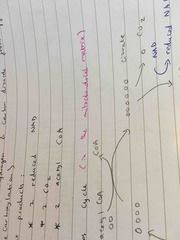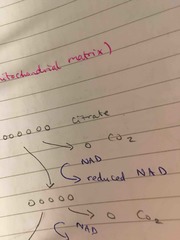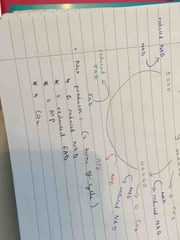![]()
![]()
![]()
Use LEFT and RIGHT arrow keys to navigate between flashcards;
Use UP and DOWN arrow keys to flip the card;
H to show hint;
A reads text to speech;
24 Cards in this Set
- Front
- Back
- 3rd side (hint)
|
What controls the rate of aerobic respiration? |
Medulla oblongata (Temperature > Intercellular enzymes) |
|
|
|
Where does glycolysis occur |
In the cytoplasm |
|
|
|
Net products for glycolysis |
- 2 pyruvate (> link reaction) - 2 NADH (> Oxidative phosphorylation) - 2 ATP |
|
|
|
Where does the link reaction happen |
Mitochondrial matrix |
|
|
|
Link reaction (process) |
Pyruvate diffuses from cytoplasm into mitochondrial matrix 1) pyruvate is decarboxylated (carbon is removed by releasing Co2) > diffuses out of cell (> waste product) 2) dehydrogenation of pyruvate reduces NAD & creates a 2C molecule (acetyl) 3) acetyl immediately combines with coenzyme A (CoA) to form acetyl coenzyme A (acetyl CoA) >> occurs twice for each molecule of Glucose |

|
|
|
Net products of link reaction |
- acetyl CoA (>Krebs cycle) - NADH (> Oxidative Phosphorylation) - C02 (>Waste product) (Occurs twice for each molecule of glucose as cycle is for ONE pyruvate) |
|
|
|
Where does the Krebs cycle take place? |
Matrix of mitochondria |
|
|
|
Krebs cycle (step 1) |
1) acetyl CoA combines with 4C compound to form a 6C compound & releases CoA ( > link reaction) |

Making a 6C compound |
|
|
Krebs cycle (step 2) |
2) 6c molecule is converted to a 5c • decarboxylation occurs - carbon dioxide is removed (> waste product) • dehydrogenation occurs - hydrogen is removed • hydrogen added to NAD > reduced NAD (> oxidative phosphorylation) |

|
|
|
Krebs cycle (step 3) |
3) 5c molecule converted to a 4c molecule • decarboxylation leads to release of Co2 (> waste product) •dehydrogenation (of 5C molecule) occurs producing 1FADH2 & 2NADH (> oxidative phosphorylation) • ATP is produced by the direct transfer of a phosphate grp from an intermediate compound to ADP (substrate level phosphorylation occurs) |

|
|
|
Net products from Krebs cycle |
• 2C02 (> waste product) • 3NADH, 1 FADH (> oxidative phosphorylation) • acetyl (> link) • ATP • for each molecule of glucose 2 cycles of Krebs cycle (as 2 molecules of pyruvate produced in glycolysis) |
|
|
|
Oxidative phosphorylation (process) |
1) NADH and FADH is oxidised in the matrix > releases electrons and H ions 2) Protons pumped through the electron carriers (electron lose energy) > from matrix to intermembrane space to create a proton/electrochemical gradient (ETC) 3) protons diffuse down conc. grad into ATP synthase > energy used to combine ADP + Pi to create ATP (CHEMIOSMOSIS) 4) Oxygen is the terminal electron acceptor & making water from electron (ETC) & protons/ hydrogen ions (CHEMIOSMOSIS) and oxygen (BLOOD) |
|
|
|
Why is the Krebs cycle in the mitochondria (instead of the cytoplasm)? |
It requires oxygen (which mitochondria contain) |
|
|
|
Why does glycolysis occur in the cytoplasm? |
Enzymes required for the reaction are in the cytoplasm (Anaerobic reaction) |
|
|
|
What are coenzymes |
- ‘helper’ - aids the binding of a substrate to the active site of a particular enzyme (Without it enzyme x function) |
|
|
|
Coenzyme A (CoA) |
Transfers acetate (/acetyl) between molecules |
|
|
|
Role of ATP synthase |
To create ATP from ADP and Pi using protons |
|
|
|
Cheismosis |
The process of creating ATP due to the movement of protons across a membrane |
|
|
|
What type of anaerobic respiration do you need to know? |
Lactate fermentation |
|
|
|
Lactate fermentation (process outline) |
1. Glucose (6C) > pyruvate (3C) through glycolysis (phosphorylation of glucose & oxidation of triose phosphate) 2. NADH (from glycolysis) transfers hydrogen to pyruvate > forms lactate (3C) & NAD 3. NAD is reused in glycolysis |
|
|
|
What type of organism does lactate fermentation? |
Animals & some bacteria |
|
|
|
How do animals break down lactic acid? |
1) cells convert the lactic acid to pyruvate by oxidation (re-enters respiration at the Krebs Cycle) 2) liver cells convert lactic acid to glucose (used for respiration/storage) |
|
|
|
What is substrate level phosphorylation? |
Phosphate is taken from a molecule and given to ADP >> to make ATP |
|
|
|
What happens in glycolysis |
• phosphorylation of glucose (6C) - 2Pi added to glucose > triose phosphate (3C) • use (hydrolysis) of 2ATP • oxidation of triose phosphate > loss of H > given to NAD > NADH • creates 4ATP by substrate level phosphorylation |
|

